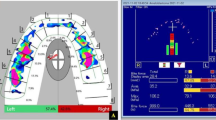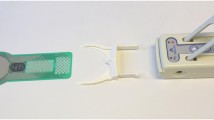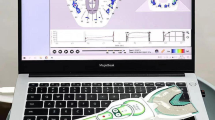Abstract
Background and Objective:
In practice, analysis of occlusion is reduced to depicting it with color-marking foils. Precise analysis that incorporates time resolution and plots the distribution of forces within the occlusion is not possible in the everyday clinical situation with the usual methods. T-Scan® III is a computer-assisted dental occlusion analyzer that depicts occlusion by means of pressure-sensitive foils. The aim of our study was to test the accuracy and reliability of this method.
Subjects and Methods:
The study population comprised 42 subjects (23 male and 19 female, aged 20–30, median age 26 years). The measurements were performed using the TScan® III from Tekscan Inc., South Boston, MA, USA. Six recordings with two foils were made for each subject and a total of 30 masticatory cycles were registered. Statistical analysis referred to the method’s measurement accuracy and reliability, as well as the influence of changing the foil and repositioning the T-Scan® III during the repeated measurements.
Results:
The percentage distribution of forces per tooth ranged from 0 to 41%. The mean measurement per tooth was 6.9% of the maximum total force exerted. The measurement error was 1%, the 1.96-fold measurement error calculated according to Bland & Altman (accuracy) was 2% and the 2.77-fold measurement error (reliability) was 2.8%. Neither changing the foil nor the repeated measuring had any statistically significant influences on the measured value.
Conclusion:
The measuring technique studied is superior to the usual methods, particularly with regard to force analysis per tooth. The level of accuracy is acceptable and no interference arising from change of foil or repeated measuring was detected. The method presented in this study therefore enhances routine diagnostics with marking foils. A combination of this method with marking foils would be ideal because the pressure-sensitive foils in this system do not produce any contact markings intraorally. This combination enables the contacts depicted on the computer to be assigned intraorally with even greater precision.
Zusammenfassung
Hintergrund und Ziel:
Die Analyse der Okklusion ist in der Praxis auf die Abbildung mit farbig markierenden Folien reduziert. Eine präzise zeitlich auflösende und die aufbauende Kraftverteilung darstellende Analyse ist mit den üblichen Methoden im klinischen Alltag nicht möglich. Ein Messverfahren, das computerunterstützt mit drucksensitiven Folien die Okklusion abbildet, ist das T-Scan®-III. Ziel unserer Untersuchung war es, Messgenauigkeit und Reliabilität dieser Methode zu prüfen.
Probanden und Methodik:
Die Studienpopulation bildeten 42 Probanden (23 männlich und 19 weiblich, 20–30 Jahre alt, Median 26 Jahre). Die Messungen wurden mit dem TScan® III der Firma Tekscan Inc., South Boston, MA, USA, durchgeführt. Bei jedem Probanden wurden insgesamt sechs Messaufzeichnungen mit zwei Folien und insgesamt 30 Kauzyklen aufgezeichnet. Die statistische Auswertung analysierte die Messgenauigkeit und Reliabilität der Methode sowie den Einfluss des Folienwechsels und der Repositionierung des T-Scan®-III während der Wiederholungsmessungen.
Ergebnisse:
Die prozentuale Kraftverteilung pro Zahn variierte von 0 bis 41%. Der mittlere Messwert pro Zahn betrug 6,9% der maximal entwickelten Gesamtkraft. Der Messfehler betrug 1%, der nach Bland & Altman berechnete 1,96fache Messfehler (Messgenauigkeit) betrug 2% und der 2,77fache Messfehler (Reliabilität) betrug 2,8%. Es wurden keine statistisch signifikanten Einflüsse am Messwert durch den Folienwechsel oder die Wiederholungsmessung festgestellt
Schlussfolgerung:
Das überprüfte Messverfahren ist, insbesondere aufgrund der Kraftanalyse pro Zahn, den üblichen Methoden überlegen. Die Messgenauigkeit ist akzeptabel und störende Einflüsse durch Folienwechsel oder wiederholte Messungen konnten nicht nachgewiesen werden. Das vorgestellte Verfahren stellt daher eine Ergänzung zur Routinediagnostik mit markierenden Folien dar. Ideal ist eine Kombination dieses Verfahrens mit markierenden Folien, da die drucksensitiven Folien des Messsystems keine Markierungen der Kontaktpunkte intraoral erzeugen. Durch eine Kombination sind die im Computer dargestellten Kontakte noch präziser intraoral zuzuordnen.
Similar content being viewed by others
References
Andrews LF. The six keys to normal occlusion. Am J Orthod 1972;62:296–309.
Balters W. Über den artikulären Ausgleich und die Entlastungstherapie beim Knirsch- und Pressgebiss. Dtsch Zahnärztl Z 1955;10:867–73.
Bland JM, Altman DG. Measurement error. Br Med J 1996;312:1654.
Bland JM, Altman DG. Measurement error. Br Med J 1996;313:744.
Conrad HJ, Schulte JK, Vallee MC. Fractures related to occlusal overload with single posterior implants: a clinical report. J Prosthet Dent 2008;99:251–6.
Dees A, Kess K, Proff P, et al. Der Einsatz des T-Scan-Systems in der okklusalen Diagnostik. Dtsch Zahn Mund Kieferheilkd Zentralbl 1992;80:145–51.
Filtchev AD, Kalachev YS. Phenomenon of domination of the strongest contacts in centric occlusion. Quintessence Int 2008;39:e99–106.
Gazit E, Fitzig S, Lieberman MA. Reproducibility of occlusal marking techniques. J Prosthet Dent 1986;55:505–9.
Isidor F. Loss of osseointegration caused by occlusal load of oral implants. A clinical and radiographic study in monkeys. Clin Oral Implants Res 1996;7:143–52.
Kerstein RB. Current applications of computerized occlusal analysis in dental medicine. Gen Dent 2001;49:521–30.
Kerstein RB. Articulating paper mark misconceptions and computerized occlusal analysis technology. Dent Implantol Update 2008;19:41–6.
Kerstein RB. T-scan III applications in mixed arch and complete arch, implant-supported prosthodontics. Dent Implantol Update 2008;19:49–53.
Komari J. Diagnostik vorzeitiger Kontakte. ZWR 1978;87:768–70.
Lawn BR, Lee JJ. Analysis of fracture and deformation modes in teeth subjected to occlusal loading. Acta Biomater 2009;5:2213–21.
Millstein PL. An evaluation of occlusal contact marking indicators: a descriptive, qualitative method. Quintessence Int Dent Dig 1983;14:813–36.
Pröschel PA. Chewing patterns in subjects with normal occlusion and with malocclusions. Semin Orthod 2006;12:138–49.
Quirynen M, Naert I, van Steenberghe D. Fixture design and overload influence marginal bone loss and fixture success in the Brånemark system. Clin Oral Implants Res 1992;3:104–11.
Rangert B, Krogh PH, Langer B, et al. Bending overload and implant fracture: a retrospective clinical analysis. Int J Oral Maxillofac Implants 1995;10:326–34.
Reiber T, Fuhr K, Hartmann H, et al. Das Zeichnungsverhalten von Okklusionindikatoren. I. Einfluss der Indikatorstärke, des Druckes und der Oberflächenmorphologie. Dtsch Zahnärztl Z 1989;44:90–3.
Reiber T, Fuhr K, Hartmann H, et al. Das Zeichnungsverhalten von Okklusionsindikatoren. Einfluss des Oberflächenmaterials und der Oberflächenrauhigkeit. ZWR 1989;98:756, 8, 60-1.
Scholz W, Pancherz H, Reichel R. Beurteilung des T-SCAN-Systems zur Registierung der okklusalen Kontaktverhältnisse. Zahnärztl Prax 1991;42:6–9.
Setz J, Geis-Gerstorfer J. Messeigenschaften eines Systems zur digitalen Okklusionsdiagnostik. Dtsch Zahnärztl Z 1990;45:S65–6.
Stern K, Kordaß B. Comparison of the Greifswald Digital Analyzing System with the T-Scan III with respect to clinical reproducibility for displaying occlusal contacts. J CranioMand Func 2010;2:107–19.
Sultana MH, Yamada K, Hanada K. Changes in occlusal force and occlusal contact area after active orthodontic treatment: a pilot study using pressure-sensitive sheets. J Oral Rehabil 2002;29:484–91.
Tawil G. Peri-implant bone loss caused by occlusal overload: repair of the peri-implant defect following correction of the traumatic occlusion. A case report. Int J Oral Maxillofac Implants 2008;23:153–7.
Throckmorton GS, Rasmussen J, Caloss R. Calibration of T-Scan sensors for recording bite forces in denture patients. J Oral Rehabil 2009;36:636–43.
Tschernitschek H, Handel G, Gunay H. T-Scan — Möglichkeiten und Grenzen eines neuen okklusionsdiagnostischen Verfahrens. Zahnärztl Prax 1990;41:54–6.
Zeng Y, Wang J, Zhou S. [Occlusal contact force and stress analysis of molars with vertical root split]. Zhonghua Kou Qiang Yi Xue Za Zhi 2000;35:142–3.
Author information
Authors and Affiliations
Corresponding author
Rights and permissions
About this article
Cite this article
Koos, B., Godt, A., Schille, C. et al. Precision of an Instrumentation-based Method of Analyzing Occlusion and its Resulting Distribution of Forces in the Dental Arch. J Orofac Orthop 71, 403–410 (2010). https://doi.org/10.1007/s00056-010-1023-7
Received:
Accepted:
Published:
Issue Date:
DOI: https://doi.org/10.1007/s00056-010-1023-7




